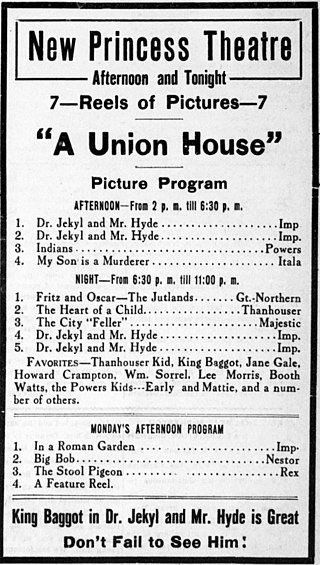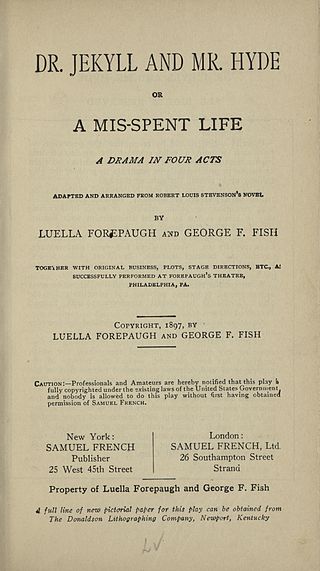The year 1920 in film involved some significant events.
The year 1916 in film involved some significant events.
The year 1915 in film involved some significant events.
1913 was a particularly fruitful year for film as an art form, and is often cited one of the years in the decade which contributed to the medium the most, along with 1917. The year was one where filmmakers of several countries made great artistic advancements, producing notable pioneering masterpieces such as The Student of Prague, Suspense, Atlantis, Raja Harischandra, Juve contre Fantomas, Quo Vadis?, Ingeborg Holm, The Mothering Heart, Ma l’amor mio non muore!, L’enfant de Paris and Twilight of a Woman's Soul.
The year 1912 in film involved some significant events.
The year 1910 in film involved some significant events.

Dr. Jekyll and Mr. Hyde is a 1920 American silent horror film produced by Famous Players–Lasky and released through Paramount/Artcraft. The film, which stars John Barrymore, is an adaptation of the 1886 novella Strange Case of Dr Jekyll and Mr Hyde by Robert Louis Stevenson. John S. Robertson directed the production, and Clara Beranger wrote the screenplay, based on the 1887 stage play by Thomas Russell Sullivan that in turn was based on the novel.

James Cruze was a silent film actor and film director.

Marguerite Snow was an American silent film and stage actress. In her early films she was billed as Margaret Snow.

Harry Benham was an American silent film actor.

Harry Brodribb Irving, was a British stage actor and actor-manager; the eldest son of Sir Henry Irving and his wife Florence, and father of designer Laurence Irving and actress Elizabeth Irving.

Dr. Pyckle and Mr. Pryde is a 1925 American silent, black-and-white comedy film, directed by Scott Pembroke and Joe Rock.

Dr. Jekyll and Mr. Hyde is a 1908 silent horror film starring Hobart Bosworth, and Betty Harte in her film debut. Directed by Otis Turner and produced by William N. Selig, this was the first film adaptation of Robert Louis Stevenson's 1886 novel Strange Case of Dr Jekyll and Mr Hyde. The screenplay was actually adapted by George F. Fish and Luella Forepaugh from their own 1897 four act stage play derived from the novel, causing a number of plot differences with the original source. Despite Stevenson's protests, this film became the model which influenced all the later film adaptations that were to come.

Dr. Jekyll and Mr. Hyde is a 1920 horror film directed and written by J. Charles Haydon, starring Sheldon Lewis, based on the 1886 novel Strange Case of Dr. Jekyll and Mr. Hyde by Robert Louis Stevenson. The Sheldon Lewis version was somewhat overshadowed by the 1920 Paramount Pictures version starring John Barrymore, which had been released just the month before.

Dr. Jekyll and Mr. Hyde is a 1913 horror film based on Robert Louis Stevenson's 1886 gothic novella Strange Case of Dr. Jekyll and Mr. Hyde. Directed by Herbert Brenon for producer Carl Laemmle's company IMP, the production stars King Baggot in the dual role of Jekyll and Hyde. The film was re-released in the United States in August 1927.

Strange Case of Dr Jekyll and Mr Hyde is an 1886 novella written by the Scottish author Robert Louis Stevenson. It is about a London lawyer, Gabriel John Utterson, who investigates strange occurrences between his old friend, Dr. Henry Jekyll and the misanthropic Mr. Hyde. In a twist ending, it is revealed that Jekyll and Hyde were the same person, and that Jekyll had regularly transformed himself into Hyde by drinking a serum.

Carl Alwin Heinrich Neuß was a German film director and actor, noted for playing Sherlock Holmes in a series of silent films during the 1910s. He also played the dual role of Jekyll and Hyde in the 1910 Danish silent film version of Dr. Jekyll and Mr. Hyde, directed by August Blom. He played Jekyll and Hyde again in the 1914 German silent film Ein Seltsamer Fall, scripted by Richard Oswald.
Max Mack (1884–1973) was a German screenwriter, film producer and director during the silent era. He is particularly known for his 1913 film The Other. He directed, and co-starred in, an early film adaptation of Dr. Jekyll and Mr. Hyde in 1914, called Ein Seltsamer Fall, written by Richard Oswald. During the 1910s, he directed nearly a hundred films in a variety of different genres.

Dr. Jekyll and Mr. Hyde, Or a Mis-Spent Life is a four-act play written in 1897 by Luella Forepaugh and George F. Fish. It is an adaptation of Strange Case of Dr Jekyll and Mr Hyde, an 1886 novella written by the Scottish author Robert Louis Stevenson. The story focuses on Henry Jekyll, a respected London doctor, and his involvement with Edward Hyde, a loathsome criminal. After Hyde murders a vicar, Jekyll's friends suspect he is helping the killer, but the truth is that Jekyll and Hyde are the same person. Jekyll has developed a potion that allows him to transform himself into Hyde and back again. When he runs out of the potion, he is trapped in his Hyde form and commits suicide.

Those Who Dare is a 1924 American silent drama film directed by John B. O'Brien and starring John Bowers, Marguerite De La Motte, and Joseph J. Dowling. Though some reference books consider it a horror film, it is not known how overt the voodoo element was, since the film no longer exists. The film co-stars a couple of actors however who were associated with the 1920s horror film genre, Sheldon Lewis, and Cesare Gravina. Director O'Brien quit directing in 1926, and spent the last ten years of his life acting in bit parts.













